Confessions of a Target Setter: Harold Stoneberger of Central Penn Sporting Clays
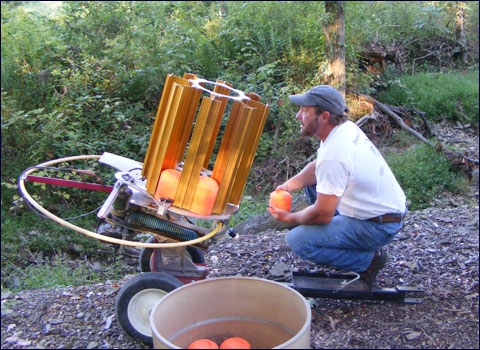
This story is the first in an occasional series called “Confessions of a Target Setter” where we speak with the men and women who try to confound us at every turn in sporting clays.
It’s August 27, 2010 and the summer heat wave that wracked the country seems to have finally broken here in the hamlet of Wellsville, Pennsylvania – home of Central Penn Sporting Clays. Owner Harold Stoneberger and his young helper, Ben Rickland, are scrambling to set targets for a 3-bird shoot the next day, and I’m here in the field with them as they share their tricks of the trade racing from one trap machine to the next, wrench in hand.
Three-bird sporting clays is a particularly challenging rendition of the game. Three birds are thrown simultaneously in a dizzying array that pushes many shooters to the limit. For Harold and Ben, the set-up involves reconfiguring their everyday presentations with precision and deliberation.
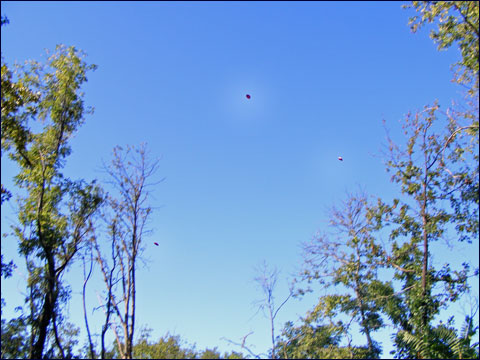
Compared with the customary true pair, a three-bird presentation is an exponential leap in complexity. The three targets must be timed so they are all achievable in an acrobatic display that defies gravity and other forces of nature such as wind, sun and vegetation.
Accompanied by Harold’s Springer Spaniel, Missy, the two target setters race to beat the deadline of tomorrow’s shoot. Harold and Ben work close, passing tools and each other, testing the stations, swapping out controllers to create a 3-bird station.
Central Penn Sporting Clays features 20 stations, mostly in open terrain. The back stretch turns into corn and sorghum fields mid-to-late summer, changing the complexity of the presentations. By station 16, the predominate features of the course transform into wooded patches where the targets buzz the branches and skip through the shadows.
For the three-bird shoot, Harold and Ben pare down the number of stations to 11 as they consolidate trap machines, throwing a total of 99 targets.
I first caught up with Harold that morning in the barn where he was kneeling in front of an empty target thrower, putting a wrench to it as he tweaked the angle and speed of the trajectory.

“We try to mix our speeds and get people confused on how fast to shoot the targets,” he said. “One of the things we like to do is slow down the target for the last shot.”
He added, “One weapon is speed. We like mixing it up.”
That’s why Harold’s quiver is loaded with different trap-machine springs for the throwing arms.
“The blue spring is fast, the yellow spring medium and the gray one is slow,” he explained. So while a peek at the machine may divulge the nature of the target before you call for the lookers, you won’t know the tension adjustment until you actually see the target – and even then, with shotgun at the ready, you could still fall prey to Harold’s shenanigans.
“We use different spring settings to make the shooter swing past some targets, or not fast enough for others, especially in reports and simo pairs,” he revealed.
On a true pair, he’ll use a gray spring for the first shot, where the target hangs there right in front you; coupled with blue-spring screamer that immediately draws your eye from the easier target, causing you to miss both.
The volatility in target speed plays into the open landscape, where there is less of an opportunity to slip thick foliage into the target line. The flat horizon that dominates Central Penn also reduces Harold’s ability to trick the eye with shadows and obstacles until shooters reach the final leg of the course.
“We have a lot of open air and people like to shoot here for the open targets because they don’t have a background,” he elaborated. “We have an open style of setting targets that I think is unique to this course. I can really take the sun into account, how it looks in the morning compared to the afternoon.”
The exposed landscape also means Harold can throw long crossers designed to “confuse shooters,” as he puts it. One of his favorite tricks is to have a pair of crossers with one machine staggered in front of the other. Call for a true pair, and what happens is the target thrown from the front the machine is the slower of the two. As the faster target overtakes it, you become totally bamboozled. “I’ll use two different springs and two different speeds,” he said of his crossing presentations. “I like to frazzle your brain.”
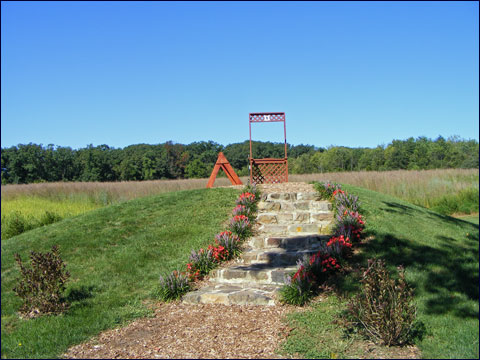
Watching the lookers on those crossers by and large is of little help when it comes to shooting them. What happens is that as you reach the break point of the slower target, the faster one comes whizzing past and your natural instincts tell you to follow it. The result? Zero, zero on the score sheet.
When it comes to setting targets Harold started out self-taught through trial and error when he purchased the Central Penn Sporting Clays operation in 2000. He ratcheted up his knowledge of the discipline by enrolling in the Course Setter Certification program of the National Sporting Clays Association.
The NSCA class instructs fledging target setters in the art and science of terrain, presentations, degree of difficulty, target color and visualization of the targets through the eyes of the shooter. Ultimately, the course should be both demanding and entertaining. Now it’s all coming together as Harold and Ben rearrange the course for the impending 3-bird shoot.
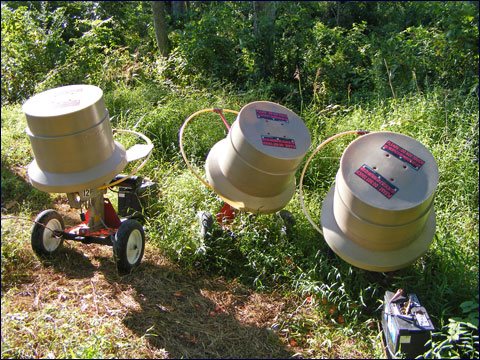
The key to a 3-bird shoot is to give the shooter plenty of time,” he said. “Then the shooter just has to know which target to shoot first.”
Harold’s formula for a 3-bird presentation is summed up as “I like to have one target that a shooter can get right away and then the next two would be right in front of him.”
This approach contrasts with his arrangements for standard sporting clays where he likes to emulate natural flight. However, his 3-bird courses tend more toward the intricate, and perhaps mathematical, as the mind spins to decipher the outlandish sequence of possibilities.
“Reading the terrain is one of the most important things in how I set them up,” he said, citing one of his favorite tricks of setting a diving target into rising ground.
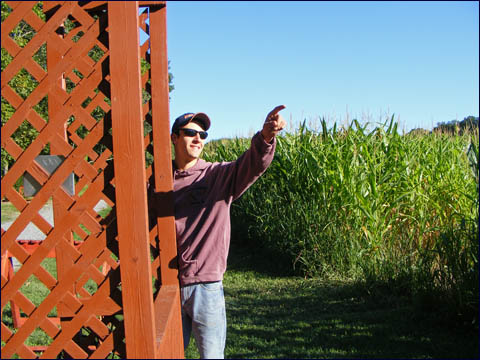
Likewise, he’ll take advantage of his crops in positioning the trap machines. “If you can see the trap machine, you have better judgment of the target,” he observed. “Now, if I can place that trap machine out in corn, so you can’t see the trap machine…” the notion trailing off as he smiles.
Still, Harold strives for “availability for all the targets. When I set targets, it’s so that you’ll hit at least 50 percent.”
In the end, Harold’s philosophy of target setting is summed up thusly: “You don’t have to set real hard targets. The shooters will beat themselves.”
Noe Roland is a contributing writer to Shotgun Life. You can contact him at letters@shotgunlife.com.
Helpful resources:
Central Penn Sporting Clays web site


Comments